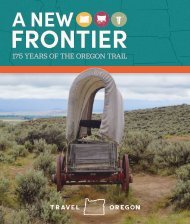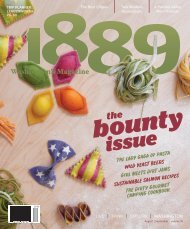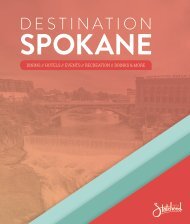1859 Spring 2010
1859 Spring 2010
1859 Spring 2010
Create successful ePaper yourself
Turn your PDF publications into a flip-book with our unique Google optimized e-Paper software.
Local Habit<br />
what i'm working on<br />
The Time<br />
Traveler’s Life<br />
interview by Kevin Max<br />
Archaeologist Dr. Dennis Jenkins went to the Paisley Caves<br />
to settle a decades-old dispute and ended up with the<br />
oldest human remains in the Western Hemisphere<br />
Q<br />
A<br />
In 1937, Luther Cressman, credited as being<br />
the founder of Oregon anthropology, first<br />
excavated the Paisley Caves, acting on the tip<br />
of Walter Perry, a local who knew a woman<br />
who had been digging there for artifacts. The<br />
Paisley Caves are a system of eight caves north<br />
of the town of Paisley at the top of the Great<br />
Basin. At this point, no human remains had<br />
been found that dated beyond the Clovis era<br />
(13,500-12,800 years ago). Clovis people were<br />
believed to have been the first inhabitants of the<br />
New World of the Western Hemisphere, and all<br />
Native Americans in North and South America<br />
were their descendents. In 1940, Cressman and<br />
his crews found camel, bison and horse bones<br />
near human artifacts that they thought were as<br />
old or older than the Clovis era. But because of<br />
Cressman’s flawed methods, a shadow of doubt<br />
was cast on his findings at the Paisley Caves for<br />
decades and beyond his death in 1994.<br />
In 2002, Dr. Dennis Jenkins, an archaeologist<br />
at the University of Oregon, returned to the<br />
Paisley Caves to test Cressman’s controversial<br />
theory that humans were living alongside<br />
camels, horses and bisons at that time in the<br />
Northern Great Basin. Jenkins, along with<br />
the UO archaeological field school, excavated<br />
the caves, practicing the most rigorous field<br />
methods, and made their own discovery—<br />
bones of camels, horses, bison and an extinct<br />
artiodactyl alongside human feces that all<br />
radiocarbon dated to around 14,280 years old.<br />
Not only had Jenkins and his crew vindicated<br />
the earlier work of Cressman, they had found<br />
and directly dated the oldest human remains<br />
(DNA) in the Western Hemisphere.<br />
Jenkins, who got his undergraduate and<br />
master’s degrees from the University of<br />
Nevada, Las Vegas, spent a lot of his adult<br />
life on archaeological projects in the Mojave<br />
Desert, before returning to Oregon for his<br />
doctorate. He is a senior staff archaeologist at<br />
the Museum of Natural and Cultural History<br />
at the University of Oregon.<br />
Outside of purely academic circles, Jenkins’<br />
findings have been celebrated with film<br />
segments on The History Channel, Oregon<br />
Field Guide segments on Oregon Public<br />
Broadcasting, magazine and newspaper<br />
articles and a recent article in the March issue<br />
of Parade, a national celebrity magazine.<br />
34 <strong>1859</strong> oregon's magazine spring <strong>2010</strong>

















